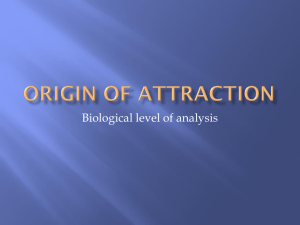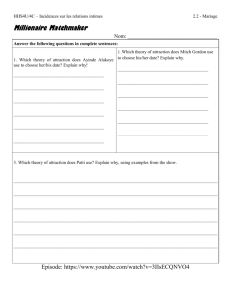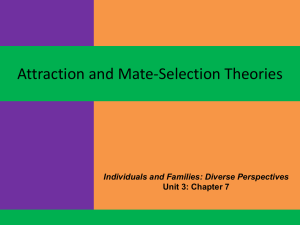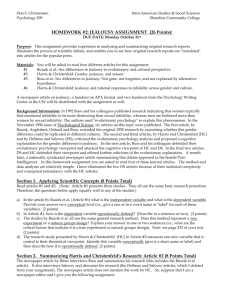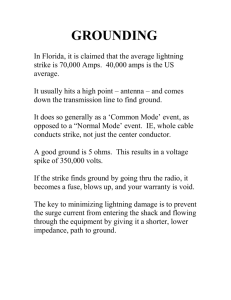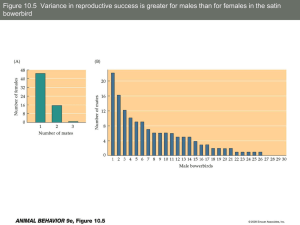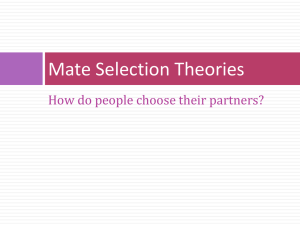here - iLearn
advertisement
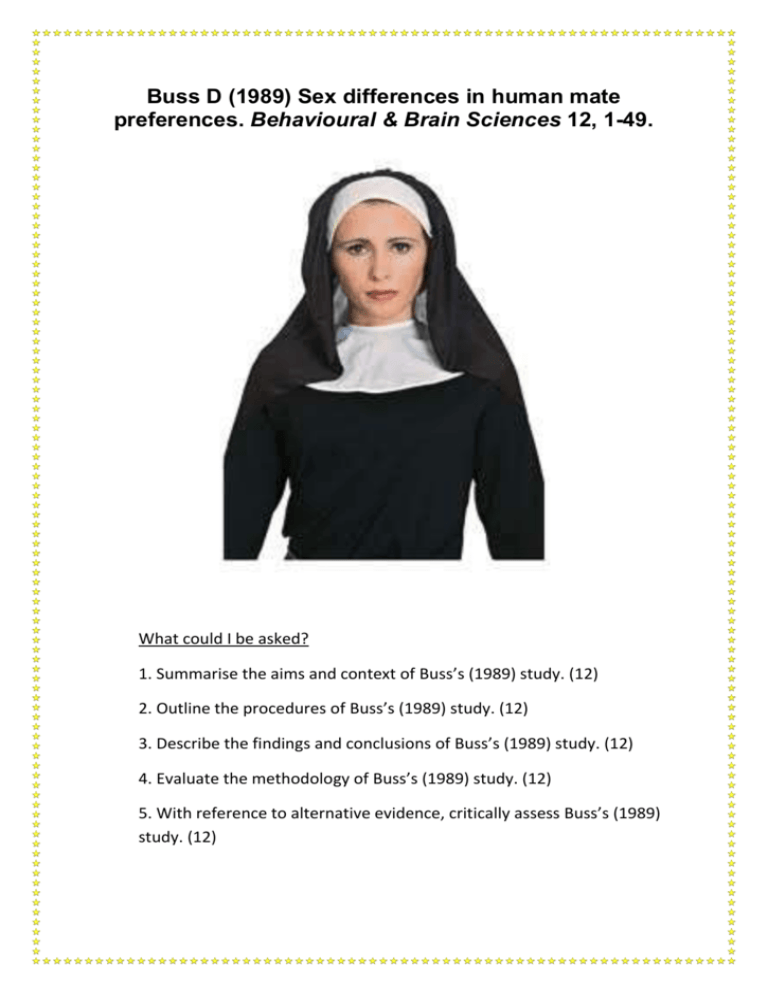
Buss D (1989) Sex differences in human mate preferences. Behavioural & Brain Sciences 12, 1-49. What could I be asked? 1. Summarise the aims and context of Buss’s (1989) study. (12) 2. Outline the procedures of Buss’s (1989) study. (12) 3. Describe the findings and conclusions of Buss’s (1989) study. (12) 4. Evaluate the methodology of Buss’s (1989) study. (12) 5. With reference to alternative evidence, critically assess Buss’s (1989) study. (12) What do I need to know about the study? aims and context procedure findings and conclusion • Why was this study carried out? What had happened in society recently? Had there been related research already carried out? What were they trying to find out? • What type of study was this? What did they actually do? Where was it carried out? Who took part? How did they measure outcomes? • What did they find out? What conclusions did they draw from this? evaluation of the methodology used • What were strengths and weaknesses of the way this study was carried out? Think about sampling issues, reliability, ethics, ecological validity etc. assessment using alternative evidence • What do other studies suggest about this study? Do they support, contradict it, or perhaps suggest there is something important the researchers didn't think of? Context & aims Definition Mate selection is ..………………………………………………………………………………………………………………… …………………………………………………………………………………………………………………………. Context This study is concerned with mate selection ie. Choosing a sexual partner. It has a background in evolutionary psychology. Evolutionary psychologists are interested in how our behaviour is affected by instincts designed to increase the chances of surviving and passing on our genes to the next generation. Buss (1989) was particularly interested in three evolutionary ideas; parental investment, reproductive value and paternal probability. Parental investment Human females invest more time and energy in reproduction than men. Men can invest as little as a few minutes of casual sex impregnating a woman. However a woman will invest far more time and energy, carrying the child through pregnancy and usually taking the bulk of responsibility for raising them to adulthood. The fact that women invest so much more in reproduction means that they tend to be fussier in their mate choice. It also means that selection of men should be influenced by their likelihood and ability to contribute to child rearing by earning lots. Exercise: what male characteristics might women find attractive according to this view? ….................................................................................................................................................. .................................................................................................................................................... Would women prefer: An older man [ ] Younger man [ ] Reproductive value For men access to fertile females is the major factor affecting their chances of reproducing. Fertility is the probability of reproduction now. Reproductive value is the probability of reproduction in the future. Fertility in women peaks in late teens or early twenties and obviously the younger the woman the longer she is likely to remain fertile. This whole approach therefore predicts that men will favour younger women. Because facial appearance gives clues to age and therefore to fertility and reproductive value, this approach also predicts that facial attractiveness in women will be very important to men. Paternal probability A third line of research is based on the idea that we want to be sure that any investment we make in reproduction ensures that we pass on our genes to future generations. For women this is easy – unless there is an unfortunate mix-up in the maternity ward there is little doubt that your child is biologically your own. For men on the other hand it is much harder to know that a child is theirs. Exercise: does this predict men will prefer chaste or sexually active women? Chaste [ ] sexually active [ ] Aim In general the more something holds true across a range of cultures the more likely it is to be a result of evolution. Buss predicted that, regardless of culture, women would tend to prefer men who were ambitious, industrious (hard working) and financially well off. It was also predicted that men would prefer young, attractive and chaste women. The aim was to test this idea by asking men and women in a range of cultures about what they liked in a potential mate. Method Sample Size: Sampling methods: This was a study because it uses a type of self-report measure. The IV (Independent Variable) was … The DV (Dependant Variable) was… How were they recruited? Settings: Procedure The questionnaires Sample characteristics: Two questionnaires were administered to all participants in their native language. Why is it important to use their native language? ………………………………… ………………………………………………. ………………………………………………. ………………………………………………. The first measured the importance of factors affecting mate choice. 18 characteristics were assessed for importance. Some were irrelevant to the study, for example sociability. Why use filler questions?........................................................................................... …………………………………………………………………………………………………. Others were the target variables of age, good looks, good financial prospects, chastity, ambition, industriousness and lack of previous sexual experience. Participants rated the importance of each factor on a 0-3 scale, where 0 was irrelevant and 3 was indispensable. The second questionnaire asked participants to rank 13 factors affecting mate choice in order of importance. Within the 13 factors were ‘good earning capacity’ and ‘physical attractiveness.’ Findings In 36 out of 37 cultures women placed significantly more importance on good financial prospects in a mate than men. The exception was Spain, where women placed only fractionally more importance than men on finance. In 34 of the 37 cultures women placed more emphasis on ambition and industriousness than men. Exercise: Do these figures support parental investment theory? …...................................................................................................................................... ......................................................................................................................................... In all 37 cultures the average age of men’s ideal woman was significantly younger than themselves and that of women’s ideal man. Similarly in all 37 samples women’s ideal man was older than themselves. The average age difference between the ideal man and the ideal woman was four years. In all 37 cultures men rated good looks in women as more important than did women about men. Exercise: Do these figures support the idea of reproductive value? …...................................................................................................................................... ......................................................................................................................................... Chastity and lack of previous sexual experience was the factor that varied most across cultures. Out of the Western European countries, only Ireland placed much emphasis on chastity. In only 23 of the 37 cultures was there a gender difference in the importance placed on chastity in a potential mate. Plot the data on to a graph. Conclusion Conclusion Overall was there support for evolutionary theory? In general men prefer attractive… In general women prefer… Yes [ ] No [ ] younger women [ ] older women [ ] poor lazy men [ ] rich hard-working men [ ] Recap For each of the following evolutionary principles there is what level of support? Recap Recap Now check your understanding by summarising the study in the boxes below: Aim • • Procedure • • Findings • • Conlcusions • • Alternative Evidence Roberts et al. (2004) We show here that both men and women judge photographs of women's faces that were taken in the fertile window of the menstrual cycle as more attractive than photographs taken during the non-fertile phase, which means that men rate women as more attractive when they are ovulating. Exercise: do these findings support Buss' ideas? Explain why. .................................................................................................................................................... .................................................................................................................................................... Schmitt et al (2003) In a major cross-cultural study by Schmitt, gender differences in mate selection were tested in 16,288 people from 53 countries. In every culture there was a significant difference on each of several measures between women and men’s preferences for variety in mates. In every case men desired a larger number of mates. Exercise: do these findings support Buss' ideas? Explain why. .................................................................................................................................................... .................................................................................................................................................... Buss ( What can we conclude from alternative evidence? Later research strongly that control and personal responsibility increases functioning and well-being. Evidence from review studies show Langer & Rodin’s results are reliable, and the inclusion on lab studies suggests their results were also Later studies show that the short-term effects Langer & Rodin found could lead to long-term health benefits. This gives strong support for the use of Langer & Rodin’s intervention; it is both low cost, and could benefit the longevity, health, functioning and motivation of elderly people. .
